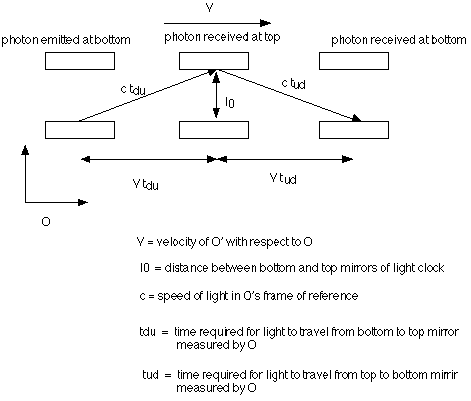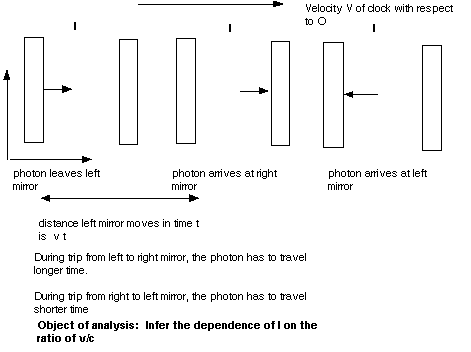Slide #1:
Time Dilation
Here we take an approach complementary to that in the book...one that does not
use the spacetime diagrams in the same way but nevertheless obtains the same results.
Consider an observer with a light clock who observes the time for a tick of an
identical light clock which moves relative to her with velocity V.
The following figure shows the set up:
 The Pythagorean theorem suffices to express the needed relation between the
time it takes to go from the bottom to the top mirror, the speed of the mirror with
respect to O, and the vertical distance the light must travel:
The Pythagorean theorem suffices to express the needed relation between the
time it takes to go from the bottom to the top mirror, the speed of the mirror with
respect to O, and the vertical distance the light must travel:
 Solving for tdu we find
Solving for tdu we find
 ---------------------------------------------------------------------------------------
Slide #2:
Similarly, for the second half of the tick:
---------------------------------------------------------------------------------------
Slide #2:
Similarly, for the second half of the tick:
 Solving for tud, we find
Solving for tud, we find
 Thus, the total time for a single tick as observed by O is:
Thus, the total time for a single tick as observed by O is:
 Now, observer O╣ would claim that the time for one tick on her light clock would be
Now, observer O╣ would claim that the time for one tick on her light clock would be
 ---------------------------------------------------------------------------------------
Slide #3
Postulate II demands that c = c╣. This
implies that
---------------------------------------------------------------------------------------
Slide #3
Postulate II demands that c = c╣. This
implies that
 Thus moving clocks run slow...time is streched or dilated.
This implies that there is no absolute time since each observer
will measure a local time interval between events which is different
from any other inertial observers with differing velocities.
---------------------------------------------------------------------------------------
Slide #4
Length Contraction
Consider again two observers╣ account of a single tick of a light clock, except
now we lay the clock on its side and analyze the distance between the two mirrors.
Thus moving clocks run slow...time is streched or dilated.
This implies that there is no absolute time since each observer
will measure a local time interval between events which is different
from any other inertial observers with differing velocities.
---------------------------------------------------------------------------------------
Slide #4
Length Contraction
Consider again two observers╣ account of a single tick of a light clock, except
now we lay the clock on its side and analyze the distance between the two mirrors.
 We now analize the single tick of this clock, taking into account the time dilation
effect as needed.
For the trip from the left mirror to the right we have:
We now analize the single tick of this clock, taking into account the time dilation
effect as needed.
For the trip from the left mirror to the right we have:
 For the trip from the right mirror to the left we have:
For the trip from the right mirror to the left we have:
 From the time dilation effect, we know that
From the time dilation effect, we know that
 and
and
 ---------------------------------------------------------------------------------------
Slide #5
Then, we find
---------------------------------------------------------------------------------------
Slide #5
Then, we find
 and
and
 Using these,
Using these,
 But c = c╣ from Postulate II, so
But c = c╣ from Postulate II, so
 Thus the distance between the two ends of the clock laying on its side depends
on the relative velocity of O and O╣.
Hence lengths are not indpendent of motion.
Thus the distance between the two ends of the clock laying on its side depends
on the relative velocity of O and O╣.
Hence lengths are not indpendent of motion.